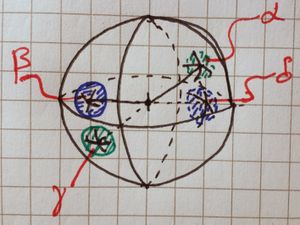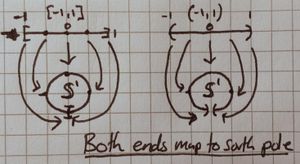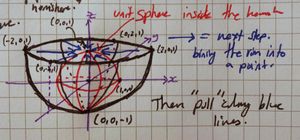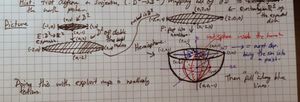Exercises:Mond - Topology - 1
Contents
Section A
Section B
Exercises 6, 7 and 8 make use of the compact-to-Hausdorff theorem
Question 6
Part I
Find a surjective continuous mapping from [ilmath][-1,1]\subset\mathbb{R} [/ilmath] to the unit circle, [ilmath]\mathbb{S}^1[/ilmath] such that it is injective except for that it sends [ilmath]-1[/ilmath] and [ilmath]1[/ilmath] to the same point in [ilmath]\mathbb{S}^1[/ilmath]. Definitions may be explicit or use a picture
Solution
We shall define [ilmath]f:[-1,1]\rightarrow\mathbb{S}^1[/ilmath] to be such a map:- [ilmath]f:t\mapsto\begin{pmatrix}-\sin(\pi(t+1))\\-\cos(\pi(t+1))\end{pmatrix} [/ilmath], this starts at the point [ilmath](1,0)[/ilmath] and goes anticlockwise around the circle of unit radius once.
- Note: I am not asked to show this is continuous, merely exhibit it.
- Note: The reason for the odd choice of [ilmath]\sin[/ilmath] for the [ilmath]x[/ilmath] coordinate, and the minus signs is because my first choice was [ilmath]f:t\mapsto\begin{pmatrix}\cos(\pi(t+1))\\\sin(\pi(t+1))\end{pmatrix} [/ilmath], however that didn't match up with the picture. The picture goes clockwise from the south pole, this would go anticlockwise from the east pole.
Part 2
Define an equivalence relation on [ilmath][-1,1][/ilmath] by declaring [ilmath]-1\sim 1[/ilmath], use part 1 above and applying the topological version of passing to the quotient to find a continuous bijection: [ilmath](:\frac{[-1,1]}{\sim}\rightarrow\mathbb{S}^1)[/ilmath]
Solution
We wish to apply passing to the quotient. Notice:
- we get [ilmath]\pi:[-1,1]\rightarrow\frac{[-1,1]}{\sim} [/ilmath], [ilmath]\pi:x\mapsto [x][/ilmath] automatically and it is continuous.
- we've already got a map, [ilmath]f[/ilmath], of the form [ilmath](:[-1,1]\rightarrow\mathbb{S}^1)[/ilmath]
In order to use the theorem we must show:
- "[ilmath]f[/ilmath] is constant on the fibres of [ilmath]\pi[/ilmath]", that is:
- [ilmath]\forall x,y\in [-1,1][\pi(x)=\pi(y)\implies f(x)=f(y)][/ilmath]
- Proof:
- Let [ilmath]x,y\in[-1,1][/ilmath] be given
- Suppose [ilmath]\pi(x)\ne\pi(y)[/ilmath], by the nature of implies we do not care about the RHS of the implication, true or false, the implication holds, so we're done
- Suppose [ilmath]\pi(x)=\pi(y)[/ilmath], we must show that this means [ilmath]f(x)=f(y)[/ilmath]
- It is easy to see that if [ilmath]x\in(-1,1)\subset\mathbb{R} [/ilmath] then [ilmath]\pi(x)=\pi(y)\implies y=x[/ilmath]
- By the nature of [ilmath]f[/ilmath] being a function (only associating an element of the domain with one thing in the codomain) and having [ilmath]y=x[/ilmath] we must have: [ilmath]f(x)=f(y)[/ilmath]
- Suppose [ilmath]x\in\{-1,1\} [/ilmath], it is easy to see that then [ilmath]\pi(x)=\pi(y)\implies y\in\{-1,1\}[/ilmath]
- But [ilmath]f(-1)=f(1)[/ilmath] so, whichever the case, [ilmath]f(x)=f(y)[/ilmath]
- It is easy to see that if [ilmath]x\in(-1,1)\subset\mathbb{R} [/ilmath] then [ilmath]\pi(x)=\pi(y)\implies y=x[/ilmath]
- Let [ilmath]x,y\in[-1,1][/ilmath] be given
We may now apply the theorem to yield:
- a unique continuous map, [ilmath]\overline{f}:[-1,1]/\sim\rightarrow\mathbb{S}^1[/ilmath] such that [ilmath]f=\overline{f}\circ\pi[/ilmath]
The question requires us to show this is a bijection, we must show that [ilmath]\newcommand{\fbar}{\bar{f} }\fbar[/ilmath] is both injective and surjective:
- Surjective: [ilmath]\forall y\in \mathbb{S}^1\exists x\in \frac{[-1,1]}{\sim}[\fbar(x)=y][/ilmath]
- There are two ways to do this:
- Note that (from passing to the quotient) that if [ilmath]f[/ilmath] is surjective, then the resulting [ilmath]\fbar[/ilmath] is surjective.
- Or the long way of showing the definition of [ilmath]\fbar[/ilmath] being a surjection, [ilmath]\forall y\in\mathbb{S}^1\exists x\in\frac{[-1,1]}{\sim}[\fbar(x)=y][/ilmath]
- Let [ilmath]y\in \mathbb{S}^1[/ilmath] be given.
- Note that [ilmath]f[/ilmath] is surjective, and [ilmath]f=\fbar\circ\pi[/ilmath], thus [ilmath]\exists p\in[-1,1][/ilmath] such that [ilmath]p=f^{-1}(y)=(\fbar\circ\pi)^{-1}(y)=\pi^{-1}(\fbar^{-1}(y))[/ilmath], thus [ilmath]\pi(p)=\fbar^{-1}(y)[/ilmath]
- Choose [ilmath]x\in[-1,1]/\sim[/ilmath] to be [ilmath]\pi(p)[/ilmath] where [ilmath]p\in[-1,1][/ilmath] exists by surjectivity of [ilmath]f[/ilmath] and is such that [ilmath]f(p)=y[/ilmath]
- Now [ilmath]\fbar(\pi(p))=f(p)[/ilmath] (by definition of [ilmath]\fbar[/ilmath]) and [ilmath]f(p)=y[/ilmath], as required.
- Let [ilmath]y\in \mathbb{S}^1[/ilmath] be given.
- There are two ways to do this:
- Injective:
- Let [ilmath]x,y\in\frac{[-1,1]}{\sim} [/ilmath] be given. We wish to show that [ilmath]\fbar(x)=\fbar(y)\implies x=y[/ilmath]
- Suppose [ilmath]\fbar(x)\ne\fbar(y)[/ilmath], then we're done, as by the nature of logical implication we do not care about the right hand side.
- Note though, by the definition of [ilmath]\fbar[/ilmath] being a function we cannot have [ilmath]x=y[/ilmath] in this case! As a function must map each element of the domain to exactly one thing of the codomain. Anyway!
- Suppose [ilmath]\fbar(x)=\fbar(y)[/ilmath], we must show that in this case we have [ilmath]x=y[/ilmath].
- By surjectivity of [ilmath]\pi:[-1,1]\rightarrow\frac{[-1,1]}{\sim} [/ilmath] we see [ilmath]\exists a\in [-1,1]\big[\pi(a)=x\big][/ilmath] and [ilmath]\exists b\in [-1,1]\big[\pi(b)=y\big][/ilmath]
- Notice now we have [ilmath]\fbar(x)=\fbar(\pi(a))[/ilmath] and that (from the passing to the quotient part of obtaining [ilmath]\fbar[/ilmath]) we have [ilmath]f=\fbar\circ\pi[/ilmath], this means:
- [ilmath]\fbar(x)=\fbar(\pi(a))=f(a)[/ilmath], we also have [ilmath]\fbar(y)=\fbar(\pi(b))=f(b)[/ilmath] from the same thoughts, but using [ilmath]y[/ilmath] and [ilmath]b[/ilmath] instead of [ilmath]x[/ilmath] and [ilmath]a[/ilmath].
- In particular: [ilmath]f(a)=f(b)[/ilmath]
- Now we have two cases, [ilmath]a\in(-1,1)[/ilmath] and [ilmath]a\in\{-1,1\} [/ilmath], we shall deal with them separately.
- We have [ilmath]f(a)=f(b)[/ilmath], suppose [ilmath]a\in(-1,1)[/ilmath]
- Recall that our very definition of [ilmath]f[/ilmath] required it to be "almost injective", specifically that [ilmath]f\big\vert_{(-1,1)}:(-1,1)\rightarrow\mathbb{S}^1[/ilmath] was injective (and that it was only "not injective" on the endpoints)
- As [ilmath]f[/ilmath] is "injective in this range" we see that to have [ilmath]f(a)=f(b)[/ilmath] means [ilmath]a=b[/ilmath] (by injectiveness of [ilmath]f\big\vert_{(-1,1)} [/ilmath])
- As [ilmath]a=b[/ilmath] we see [ilmath]y=\pi(b)=\pi(a)=x[/ilmath] and conclude [ilmath]y=x[/ilmath] - as required.
- We have [ilmath]f(a)=f(b)[/ilmath], and this time [ilmath]a\in\{-1,1\} [/ilmath] instead
- Again by definition of [ilmath]f[/ilmath], we recall [ilmath]f(-1)=f(1)[/ilmath] - it maps the endpoints of [ilmath][-1,1][/ilmath] to the same point in [ilmath]\mathbb{S}^1[/ilmath].
- To have [ilmath]f(a)=f(b)[/ilmath] clearly means that [ilmath]b\in\{-1,1\}[/ilmath] (regardless of what value [ilmath]a\in\{-1,1\} [/ilmath] takes)
- But [ilmath]\pi(a)=[a]=\{-1,1\}[/ilmath] and also [ilmath]\pi(b)=[b]=\{-1,1\}[/ilmath]
- So we see [ilmath]y=\pi(b)=\{-1,1\}=\pi(a)=x[/ilmath], explicitly: [ilmath]x=y[/ilmath], as required
- We have [ilmath]f(a)=f(b)[/ilmath], suppose [ilmath]a\in(-1,1)[/ilmath]
- We have shown that in either case [ilmath]x=y[/ilmath]
- Notice now we have [ilmath]\fbar(x)=\fbar(\pi(a))[/ilmath] and that (from the passing to the quotient part of obtaining [ilmath]\fbar[/ilmath]) we have [ilmath]f=\fbar\circ\pi[/ilmath], this means:
- By surjectivity of [ilmath]\pi:[-1,1]\rightarrow\frac{[-1,1]}{\sim} [/ilmath] we see [ilmath]\exists a\in [-1,1]\big[\pi(a)=x\big][/ilmath] and [ilmath]\exists b\in [-1,1]\big[\pi(b)=y\big][/ilmath]
- Suppose [ilmath]\fbar(x)\ne\fbar(y)[/ilmath], then we're done, as by the nature of logical implication we do not care about the right hand side.
- Since [ilmath]x,y\in\frac{[-1,1]}{\sim}[/ilmath] was arbitrary, we have shown this for all [ilmath]x,y[/ilmath]. The very definition of [ilmath]\fbar[/ilmath] being injective.
- Let [ilmath]x,y\in\frac{[-1,1]}{\sim} [/ilmath] be given. We wish to show that [ilmath]\fbar(x)=\fbar(y)\implies x=y[/ilmath]
Thus [ilmath]\fbar[/ilmath] is a bijection
Part 3
Show that [ilmath][-1,1]/\sim[/ilmath] is homeomorphic to [ilmath]\mathbb{S}^1[/ilmath]
Solution
To apply the "compact-to-Hausdorff theorem" we require:
- A continuous bijection, which we have, namely [ilmath]\fbar:\frac{[-1,1]}{\sim}\rightarrow\mathbb{S}^1[/ilmath]
- the domain space, [ilmath]\frac{[-1,1]}{\sim} [/ilmath], to be compact, and
- the codomain space, [ilmath]\mathbb{S}^1[/ilmath], to be Hausdorff
We know the image of a compact set is compact, and that closed intervals are compact in [ilmath]\mathbb{R} [/ilmath], thus [ilmath][-1,1]/\sim=\pi([1-,1])[/ilmath] must be compact. We also know [ilmath]\mathbb{R}^2[/ilmath] is Hausdorff and every subspace of a Hausdorff space is Hausdorff, thus [ilmath]\mathbb{S}^1[/ilmath] is Hausdorff.
We apply the theorem:
- [ilmath]\fbar[/ilmath] is a homeomorphism
Question 7
Let [ilmath]D^2[/ilmath] denote the closed unit disk in [ilmath]\mathbb{R}^2[/ilmath] and define an equivalence relation on [ilmath]D^2[/ilmath] by setting [ilmath]x_1\sim x_2[/ilmath] if [ilmath]\Vert x_1\Vert=\Vert x_2\Vert=1[/ilmath] ("collapsing the boundary to a single point"). Show that [ilmath]\frac{D^2}{\sim} [/ilmath] is homeomorphic to [ilmath]\mathbb{S}^2[/ilmath] - the sphere.
- Hint: first define a surjection [ilmath](:D^2\rightarrow\mathbb{S}^2)[/ilmath] mapping all of [ilmath]\partial D^2[/ilmath] to the north pole. This may be defined using a good picture or a formula.
Solution
Definitions:
- [ilmath]H[/ilmath] denotes the hemisphere in my picture.
- [ilmath]E:D^2\rightarrow H[/ilmath] is the composition of maps in my diagram that take [ilmath]D^2[/ilmath], double its radius, then embed it in [ilmath]\mathbb{R}^3[/ilmath] then "pop it out" into a hemisphere. We take it as obvious that it is a homeomorphism
- [ilmath]f':H\rightarrow\mathbb{S}^2[/ilmath], this is the map in the top picture. It takes the hemisphere and pulls the boundary/rim in (along the blue lines) to the north pole of the red sphere. [ilmath]f'(\partial H)=(0,0,1)\in\mathbb{R}^3[/ilmath], it should be clear that for all [ilmath]x\in H-\partial H[/ilmath] that [ilmath]f'(x)[/ilmath] is intended to be a point on the red sphere and that [ilmath]f'\big\vert_{H-\partial H}[/ilmath] is injective. It is also taken as clear that [ilmath]f'[/ilmath] is surjective
- Note: Click the pictures for a larger version
- [ilmath]\frac{D^2}{\sim} [/ilmath] and [ilmath]D^2/\sim[/ilmath] denote the quotient space, with this definition we get a canonical projection, [ilmath]\pi:D^2\rightarrow D^2/\sim[/ilmath] given by [ilmath]\pi:x\mapsto [x][/ilmath] where [ilmath][x][/ilmath] denotes the equivalence class of [ilmath]x[/ilmath]
- Lastly, we define [ilmath]f:D^2\rightarrow\mathbb{S}^2[/ilmath] to be the composition of [ilmath]E[/ilmath] and [ilmath]f'[/ilmath], that is: [ilmath]f:=f'\circ E[/ilmath], meaning [ilmath]f:x\mapsto f'(E(x))[/ilmath]
The situation is shown diagramatically below:
- [ilmath]\xymatrix{ D^2 \ar[d]_\pi \ar[r]^E \ar@/^1.5pc/[rr]^{f:=f'\circ E} & H \ar[r]^{f'} & \mathbb{S}^2 \\ \frac{D^2}{\sim} }[/ilmath]
Outline of the solution:
- We then want apply the passing to the quotient theorem to yield a commutative diagram: [ilmath]\xymatrix{ D^2 \ar[d]_\pi \ar[r]^E \ar@/^1.5pc/[rr]^{f} & H \ar[r]^{f'} & \mathbb{S}^2 \\ \frac{D^2}{\sim} \ar@{.>}[urr]_{\bar{f} } }[/ilmath]
- The commutative diagram part merely means that [ilmath]f=\bar{f}\circ\pi[/ilmath][Note 1]. We get [ilmath]f=\bar{f}\circ\pi[/ilmath] as a result of the passing-to-the-quotient theorem.
- We take this diagram as showing morphisms in the TOP category, meaning all arrows shown represent continuous maps. (Obviously...)
- Lastly, we will show that [ilmath]\bar{f} [/ilmath] is a homeomorphism using the compact-to-Hausdorff theorem
Solution body
First we must show the requirements for applying passing to the quotient are satisfied.
- We know already the maps involved are continuous and that [ilmath]\pi[/ilmath] is a quotient map. We only need to show:
- [ilmath]f[/ilmath] is constant on the fibres of [ilmath]\pi[/ilmath], which is equivalent to:
- [ilmath]\forall x,y\in D^2[\pi(x)=\pi(y)\implies f(x)=f(y)][/ilmath]
- [ilmath]f[/ilmath] is constant on the fibres of [ilmath]\pi[/ilmath], which is equivalent to:
- Let us show this remaining condition:
- Let [ilmath]x,y\in D^2[/ilmath] be given.
- Suppose [ilmath]\pi(x)\ne\pi(y)[/ilmath], then by the nature of logical implication the implication is true regardless of [ilmath]f(x)[/ilmath] and [ilmath]f(y)[/ilmath]'s equality. We're done in this case.
- Suppose [ilmath]\pi(x)=\pi(y)[/ilmath], we must show that in this case [ilmath]f(x)=y(y)[/ilmath].
- Suppose [ilmath]x\in D^2-\partial D^2[/ilmath] (meaning [ilmath]x\in D^2[/ilmath] but [ilmath]x\notin \partial D^2[/ilmath], ie [ilmath]-[/ilmath] denotes relative complement)
- In this case we must have [ilmath]x=y[/ilmath], as otherwise we'd not have [ilmath]\pi(x)=\pi(y)[/ilmath] (for [ilmath]x\in D^2-\partial D^2[/ilmath] we have [ilmath]\pi(x)=[x]=\{x\}[/ilmath], that is that the equivalence classes are singletons. So if [ilmath]\pi(x)=\pi(y)[/ilmath] we must have [ilmath]\pi(y)=[y]=\{x\}=[x]=\pi(x)[/ilmath]; so [ilmath]y[/ilmath] can only be [ilmath]x[/ilmath])
- If [ilmath]x=y[/ilmath] then by the nature of [ilmath]f[/ilmath] being a function we must have [ilmath]f(x)=f(y)[/ilmath], we're done in this case
- Suppose [ilmath]x\in \partial D^2[/ilmath] (the only case not covered) and [ilmath]\pi(x)=\pi(y)[/ilmath], we must show [ilmath]f(x)=f(y)[/ilmath]
- Clearly if [ilmath]x\in\partial D^2[/ilmath] and [ilmath]\pi(x)=\pi(y)[/ilmath] we must have [ilmath]y\in\partial D^2[/ilmath].
- [ilmath]E(x)[/ilmath] is mapped to the boundary/rim of [ilmath]H[/ilmath], as is [ilmath]E(y)[/ilmath] and [ilmath]f'(\text{any point on the rim of }H)=(0,0,1)\in\mathbb{R}^3[/ilmath]
- Thus [ilmath]f'(E(x))=f'(E(y))[/ilmath], but [ilmath]f'(E(x))[/ilmath] is the very definition of [ilmath]f(x)[/ilmath], so clearly:
- [ilmath]f(x)=f(y)[/ilmath] as required.
- Clearly if [ilmath]x\in\partial D^2[/ilmath] and [ilmath]\pi(x)=\pi(y)[/ilmath] we must have [ilmath]y\in\partial D^2[/ilmath].
- Suppose [ilmath]x\in D^2-\partial D^2[/ilmath] (meaning [ilmath]x\in D^2[/ilmath] but [ilmath]x\notin \partial D^2[/ilmath], ie [ilmath]-[/ilmath] denotes relative complement)
- Let [ilmath]x,y\in D^2[/ilmath] be given.
We may now apply the passing to the quotient theorem. This yields:
- A continuous map, [ilmath]\bar{f}:D^2/\sim\rightarrow\mathbb{S}^2[/ilmath] where [ilmath]f=\bar{f}\circ\pi[/ilmath]
In order to apply the compact-to-Hausdorff theorem and show [ilmath]\bar{f} [/ilmath] is a homeomorphism we must show it is continuous and bijective. We already have continuity (as a result of the passing-to-the-quotient theorem), we must show it is bijective.
We must show [ilmath]\bar{f} [/ilmath] is both surjective and injective:
- Surjectivity: We can get this from the definition of [ilmath]\bar{f} [/ilmath], recall on the passing to the quotient (function) page that:
- if [ilmath]f[/ilmath] is surjective then [ilmath]\bar{f} [/ilmath] (or [ilmath]\tilde{f} [/ilmath] as the induced function is on that page) is surjective also
- I've already done it "the long way" once in this assignment, and I hope it is not frowned upon if I decline to do it again.
- if [ilmath]f[/ilmath] is surjective then [ilmath]\bar{f} [/ilmath] (or [ilmath]\tilde{f} [/ilmath] as the induced function is on that page) is surjective also
- Injectivity: This follows a similar to gist as to what we've done already to show we could apply "passing to the quotient" and for the other questions where we've had to show a factored map is injective. As before:
- Let [ilmath]x,y\in\frac{D^2}{\sim} [/ilmath] be given.
- Suppose [ilmath]\bar{f}(x)\ne\bar{f}(y)[/ilmath] - then by the nature of logical implication we do not care about the RHS and are done regardless of [ilmath]x[/ilmath] and [ilmath]y[/ilmath]'s equality
- Once again I note we must really have [ilmath]x\ne y[/ilmath] as if [ilmath]x=y[/ilmath] then by definition of [ilmath]\bar{f} [/ilmath] being a function we must also have [ilmath]\bar{f}(x)=\bar{f}(y)[/ilmath], anyway!
- Suppose that [ilmath]\bar{f}(x)=\bar{f}(y)[/ilmath], we must show that in this case [ilmath]x=y[/ilmath].
- Note that by surjectivity of [ilmath]\pi[/ilmath] that: [ilmath]\exists a\in D^2[\pi(a)=x][/ilmath] and [ilmath]\exists b\in D^2[\pi(b)=y][/ilmath], so [ilmath]\bar{f}(x)=\bar{f}(\pi(a))[/ilmath] and [ilmath]\bar{f}(y)=\bar{f}(\pi(b))[/ilmath], also, as [ilmath]\bar{f} [/ilmath] was the result of factoring, we have [ilmath]f=\bar{f}\circ\pi[/ilmath], so we see [ilmath]\bar{f}(\pi(a))=f(a)[/ilmath] and [ilmath]\bar{f}(\pi(b))=f(b)[/ilmath], since [ilmath]\bar{f}(x)=\bar{f}(y)[/ilmath] we get [ilmath]f(a)=f(b)[/ilmath] and [ilmath]\bar{f}(\pi(a))=\bar{f}(\pi(b))[/ilmath] also.
- We now have 2 cases, [ilmath]a\in D^2-\partial D^2[/ilmath] and [ilmath]a\in \partial D^2[/ilmath] respectively:
- Suppose [ilmath]a\in D^2-\partial D^2[/ilmath]
- As we have [ilmath]f(a)=f(b)[/ilmath] we must have [ilmath]b=a[/ilmath], as if [ilmath]b\ne a[/ilmath] then [ilmath]f(b)\ne f(a)[/ilmath], because [ilmath]f\big\vert_{D^2-\partial D^2}:(D^2-\partial D^2)\rightarrow\mathbb{S}^2[/ilmath] is injective[Note 2] by construction
- If [ilmath]b=a[/ilmath] then [ilmath]y=\pi(b)=\pi(a)=x[/ilmath] so [ilmath]y=x[/ilmath] as required (this is easily recognised as [ilmath]x=y[/ilmath])
- As we have [ilmath]f(a)=f(b)[/ilmath] we must have [ilmath]b=a[/ilmath], as if [ilmath]b\ne a[/ilmath] then [ilmath]f(b)\ne f(a)[/ilmath], because [ilmath]f\big\vert_{D^2-\partial D^2}:(D^2-\partial D^2)\rightarrow\mathbb{S}^2[/ilmath] is injective[Note 2] by construction
- Suppose [ilmath]a\in\partial D^2[/ilmath]
- Then to have [ilmath]f(a)=f(b)[/ilmath] we must have [ilmath]b\in\partial D^2[/ilmath]
- This means [ilmath]a\sim b[/ilmath], and that means [ilmath]\pi(a)=\pi(b)[/ilmath]
- But [ilmath]y=\pi(b)[/ilmath] and [ilmath]x=\pi(a)[/ilmath], so we arrive at: [ilmath]x=\pi(a)=\pi(b)=y[/ilmath], or [ilmath]x=y[/ilmath], as required.
- This means [ilmath]a\sim b[/ilmath], and that means [ilmath]\pi(a)=\pi(b)[/ilmath]
- Then to have [ilmath]f(a)=f(b)[/ilmath] we must have [ilmath]b\in\partial D^2[/ilmath]
- Suppose [ilmath]a\in D^2-\partial D^2[/ilmath]
- We now have 2 cases, [ilmath]a\in D^2-\partial D^2[/ilmath] and [ilmath]a\in \partial D^2[/ilmath] respectively:
- Note that by surjectivity of [ilmath]\pi[/ilmath] that: [ilmath]\exists a\in D^2[\pi(a)=x][/ilmath] and [ilmath]\exists b\in D^2[\pi(b)=y][/ilmath], so [ilmath]\bar{f}(x)=\bar{f}(\pi(a))[/ilmath] and [ilmath]\bar{f}(y)=\bar{f}(\pi(b))[/ilmath], also, as [ilmath]\bar{f} [/ilmath] was the result of factoring, we have [ilmath]f=\bar{f}\circ\pi[/ilmath], so we see [ilmath]\bar{f}(\pi(a))=f(a)[/ilmath] and [ilmath]\bar{f}(\pi(b))=f(b)[/ilmath], since [ilmath]\bar{f}(x)=\bar{f}(y)[/ilmath] we get [ilmath]f(a)=f(b)[/ilmath] and [ilmath]\bar{f}(\pi(a))=\bar{f}(\pi(b))[/ilmath] also.
- Suppose [ilmath]\bar{f}(x)\ne\bar{f}(y)[/ilmath] - then by the nature of logical implication we do not care about the RHS and are done regardless of [ilmath]x[/ilmath] and [ilmath]y[/ilmath]'s equality
- Let [ilmath]x,y\in\frac{D^2}{\sim} [/ilmath] be given.
We now know [ilmath]\bar{f} [/ilmath] is a continuous bijection.
Noting that [ilmath]D^2[/ilmath] is closed and bounded we can apply the Heine–Borel theorem to show [ilmath]D^2[/ilmath] is compact. As [ilmath]\pi:D^2\rightarrow\frac{D^2}{\sim} [/ilmath] is continuous (see quotient topology for information) we can use "the image of a compact set is compact" to conclude that [ilmath]\frac{D^2}{\sim} [/ilmath] is compact.
A subspace of a Hausdorff space is a Hausdorff space, as [ilmath]\mathbb{S}^2[/ilmath] is a topological subspace of [ilmath]\mathbb{R}^3[/ilmath], [ilmath]\mathbb{S}^2[/ilmath] is Hausdorff.
We may now use the compact-to-Hausdorff theorem (as [ilmath]\bar{f} [/ilmath] is a bijective continuous map between a compact space to a Hausdorff space) to show that [ilmath]\bar{f} [/ilmath] is a homeomorphism
As we have found a homeomorphism between [ilmath]\frac{D^2}{\sim} [/ilmath] and [ilmath]\mathbb{S}^2[/ilmath] we have shown they are homeomorphic, written:
- [ilmath]\frac{D^2}{\sim}\cong\mathbb{S}^2[/ilmath].
Question 8
Suppose that [ilmath]f:X\rightarrow Y[/ilmath] is a continuous function that is also surjective, and let [ilmath]\sim[/ilmath] denote the equivalence relation induced by [ilmath]f[/ilmath] on [ilmath]X[/ilmath].
Show that if [ilmath]X[/ilmath] is compact and [ilmath]Y[/ilmath] is Hausdorff then [ilmath]\frac{X}{\sim} [/ilmath] is homeomorphic to [ilmath]Y[/ilmath].
Which theorem of group theory does this resemble?
Proof
Recall the result of question 5:
Using the linked theorem we instantly obtain:
- [ilmath]\bar{f}:\frac{X}{\sim}\rightarrow Y[/ilmath] that is a continuous bijection
- We must show this is a homeomorphism.
Suppose [ilmath]X[/ilmath] is compact, then [ilmath]\frac{X}{\sim} [/ilmath] is compact also as the image of a compact set is compact and [ilmath]\pi:X\rightarrow\frac{X}{\sim} [/ilmath] is continuous (see quotient topology for more details)
We then apply the "compact-to-Hausdorff theorem" which shows us that [ilmath]\bar{f} [/ilmath] is actually a homeomorphism
This is similar to the first group isomorphism theorem (in the case the map is surjective) certainly in a categorical sense. The group theorem "factors through the kernel of the morphism" where as this "factors through the equivalence relation induced by the morphism" and they both yield an isomorphism (a homeomorphism is the term for a topological isomorphism. Here are diagrams:
- For any (surjective) group homomorphism [ilmath]\varphi:G\rightarrow H[/ilmath] (for arbitrary groups) we get a group isomorphism, [ilmath]\bar{\varphi} [/ilmath]. [ilmath]\xymatrix{ G \ar[r]^\varphi \ar[d]_\pi & H \\ {G/\text{Ker}(\varphi)} \ar@{.>}[ur]_{\bar{\varphi} } }[/ilmath], and,
- For any (surjective) continuous map, [ilmath]f:X\rightarrow Y[/ilmath] (for an arbitrary compact space [ilmath]X[/ilmath], and arbitrary Hausdorff space [ilmath]Y[/ilmath]) we get a homeomorphism/topological isomorphism [ilmath]\bar{f} [/ilmath]. [ilmath]\xymatrix{ X \ar[d]_\pi \ar[r]^f & Y \\ \frac{X}{x_1\sim x_2\iff f(x_1)=f(x_2)} \ar@{.>}[ur]_(.6){\bar{f} } }[/ilmath]
In both instances the "denominator" of the quotient depends on the map, factoring (as in passing to the quotient (function) is involved, rather than passing to the quotient (topology) and we get an isomorphism.
I hope this is the similarity that is expected.
Question 9
The real projective plane, [ilmath]\mathbb{RP}^2[/ilmath] is defined as the quotient of the sphere, [ilmath]\mathbb{S}^2[/ilmath], by the equivalence relation that defines (for [ilmath]x\in\mathbb{S}^2\subset\mathbb{R}^3[/ilmath]) [ilmath]x\sim -x[/ilmath], that is it identifies antipodal points.
Show that [ilmath]\mathbb{RP}^2[/ilmath] is Hausdorff
Definitions
- We denote by [ilmath]\pi:\mathbb{S}^2\rightarrow\frac{\mathbb{S}^2}{\sim} [/ilmath] the canonical projection of the equivalence relation, [ilmath]\sim[/ilmath]. Note that this is a quotient map when we consider [ilmath]\frac{\mathbb{S}^2}{\sim} [/ilmath] with the quotient topology.
Solution outline

So rather than [ilmath]\epsilon\le\frac{1}{2}d(\alpha,\beta)[/ilmath] (for [ilmath]d[/ilmath] being the Euclidean metric of [ilmath]\mathbb{R}^3[/ilmath]) we must make sure that the ball at the antipodal point doesn't touch any others too!
It is clear that if [ilmath]\epsilon\le\frac{1}{2} d(\alpha,\gamma)=1[/ilmath] that the balls centred at [ilmath]\alpha[/ilmath] and [ilmath]\gamma[/ilmath] (or [ilmath]\beta[/ilmath] and [ilmath]\delta[/ilmath]) wont touch, we must make sure that [ilmath]\alpha[/ilmath] and [ilmath]\beta[/ilmath] don't touch, so use [ilmath]\epsilon\le d(\alpha,\beta)[/ilmath].
But as the diagram shows, [ilmath]\alpha[/ilmath] and [ilmath]\delta[/ilmath] could be rather close! (or equivalently, [ilmath]\gamma[/ilmath] and [ilmath]\beta[/ilmath]), so we need [ilmath]\epsilon<\frac{1}{2} d(\alpha,\delta)[/ilmath] too!
We can boil all these down into [ilmath]\epsilon\le\frac{1}{2}\text{min}(\{d(\alpha,\beta),d(\alpha,\delta)\})[/ilmath]
With this in mind, let [ilmath]a,b\in\mathbb{RP}^2[/ilmath] be given. We need to find two open sets (well... neighbourhoods will do... but open sets are neighbourhoods!), let's say [ilmath]U_a[/ilmath] and [ilmath]U_b[/ilmath] such that:
- [ilmath]a\in U_a[/ilmath], [ilmath]b\in U_b[/ilmath] and [ilmath]U_a\cap U_b=\emptyset[/ilmath]
Well:
- [ilmath]U_a[/ilmath] is open in [ilmath]\mathbb{RP}^2[/ilmath]
- [ilmath]\pi^{-1}(U_a)[/ilmath] is open in [ilmath]\mathbb{S}^2[/ilmath]
- there exists an open set, [ilmath]V_a[/ilmath] in [ilmath]\mathbb{R}^3[/ilmath] such that [ilmath]V_a\cap\mathbb{S}^2=\pi^{-1}(U_a)[/ilmath]
Of course, the open balls of [ilmath]\mathbb{R}^3[/ilmath] are a basis, so we can think of [ilmath]V_a[/ilmath] as a union of open balls, or possibly just an open ball (as basis sets themselves are open, and also as an open ball can be expressed as a union of open balls).
This changes the question into, in terms of [ilmath]a[/ilmath] and [ilmath]b[/ilmath], what size balls can we consider in [ilmath]\mathbb{R}^3[/ilmath] such that they're disjoint. There's a caveat here. This is what is shown in the diagram.
If [ilmath]a[/ilmath] and [ilmath]b[/ilmath] are "far apart" on [ilmath]\mathbb{RP}^2[/ilmath], it is entirely possible (in the pre-image under [ilmath]\pi[/ilmath]) that the antipodal point of one is near the other!
So we must be careful to make sure our balls do not overlap at all!
Consider now [ilmath]\{x,-x\}=\pi^{-1}(a)[/ilmath] and [ilmath]\{y,-y\}=\pi^{-1}(b)[/ilmath]:
We notice also there is extra "structure" on [ilmath]\mathbb{R}^3[/ilmath], namely that it is a normed space, [ilmath](\mathbb{R}^3,\Vert\cdot\Vert)[/ilmath], and we consider the metric induced by the norm as the metric, [ilmath]d[/ilmath], for a metric space, [ilmath](\mathbb{R}^3,d)[/ilmath], then we see:
- [ilmath]d(x,y)=d(y,x)[/ilmath] (by the symmetric property of a metric) and
- [ilmath]d(-x,y)=\Vert -x-y\Vert = \Vert(-1)x+y\Vert=\Vert x+y\Vert=d(x,-y)[/ilmath]
- We don't need to consider [ilmath]d(x,-x)[/ilmath] and [ilmath]d(y,-y)[/ilmath], also [ilmath]d(x,x)=d(y,y)=0[/ilmath] is not very helpful
So take:
- [ilmath]0<\epsilon\le\frac{1}{2}\text{min}(\{d(x,y),d(x,-y)\})[/ilmath] (Note: there are "safer" choices for the upper bound to put on [ilmath]\epsilon[/ilmath], eg [ilmath]\frac{1}{4} \text{min}(\{d(x,y),d(x,-y)\})[/ilmath] rather than [ilmath]\frac{1}{2} \text{min}(\{d(x,y),d(x,-y)\})[/ilmath] - I hope I don't need to prove [ilmath]\frac{1}{2} [/ilmath] is sufficient? However for a discussion see the caption of the picture on the right.)
- This should explain why [ilmath]d(x,-x)[/ilmath] and [ilmath]d(y,-y)[/ilmath] are of no use!
Then just place one of these open balls of radius [ilmath]\epsilon[/ilmath] at each of the 4 points. Job done!
Solution
We wish to show that [ilmath]\mathbb{RP}^2[/ilmath] is Hausdorff.
- Let [ilmath]a,b\in\mathbb{RP}^2[/ilmath] be given such that [ilmath]a\ne b[/ilmath], then
- there exist [ilmath]x,y\in\mathbb{S}^2[/ilmath] such that [ilmath]\pi^{-1}(a)=\{x,-x\}[/ilmath] and [ilmath]\pi^{-1}(b)=\{y,-y\}[/ilmath]
- Let [ilmath]\epsilon:=\frac{1}{2}\text{min}(\{d(x,y),d(x,-y)\})[/ilmath] Note that [ilmath]d(x,-y)=d(-x,y)[/ilmath] - see above in the outline section
- Let [ilmath]V_a:=B_\epsilon(x)\cup B_\epsilon(-x)\subset\mathbb{R}^3[/ilmath] and [ilmath]V_b:=B_\epsilon(y)\cup B_\epsilon(-y)\subset\mathbb{R}^3[/ilmath]. These are open (in [ilmath]\mathbb{R}^3[/ilmath]) as open balls are open sets, and the union of open sets is open.
- Now define [ilmath]U_a:=V_a\cap\mathbb{S}^2[/ilmath] and [ilmath]U_b:=V_b\cap\mathbb{S}^2[/ilmath], these are open in [ilmath]\mathbb{S}^2[/ilmath] (considered with the subspace topology it inherits from [ilmath]\mathbb{R}^3[/ilmath] - as mentioned in the outline)
- Recall [ilmath]U\in\mathcal{P}(\mathbb{RP}^2)[/ilmath] is open if and only if [ilmath]\pi^{-1}(U)[/ilmath] is open in [ilmath]\mathbb{S}^2[/ilmath]
- Thus:
- [ilmath]\pi(U_a)[/ilmath] is open if and only if [ilmath]\pi^{-1}(\pi(U_a))[/ilmath] is open in [ilmath]\mathbb{S}^2[/ilmath] and
- [ilmath]\pi(U_b)[/ilmath] is open if and only if [ilmath]\pi^{-1}(\pi(U_b))[/ilmath] is open in [ilmath]\mathbb{S}^2[/ilmath]
- It should be clear that [ilmath]\pi^{-1}(\pi(U_a))=U_a[/ilmath] and [ilmath]\pi^{-1}(\pi(U_b))=U_b[/ilmath] (by their very construction)
- Thus:
- [ilmath]\pi(U_a)[/ilmath] is open if and only if [ilmath]\pi^{-1}(\pi(U_a))=U_a[/ilmath] is open in [ilmath]\mathbb{S}^2[/ilmath] and
- [ilmath]\pi(U_b)[/ilmath] is open if and only if [ilmath]\pi^{-1}(\pi(U_b))=U_b[/ilmath] is open in [ilmath]\mathbb{S}^2[/ilmath]
- As both right-hand-sides are true, we see [ilmath]\pi(U_a)[/ilmath] and [ilmath]\pi(U_b)[/ilmath] are both open in [ilmath]\mathbb{RP}^2[/ilmath]
- We must now show [ilmath]U_a[/ilmath] and [ilmath]U_b[/ilmath] are disjoint.
- Suppose there exists a [ilmath]p\in \pi(U_a)\cap\pi(U_b)[/ilmath] (that is that they're not disjoint and [ilmath]x[/ilmath] is in both of them), then:
- clearly [ilmath]\exists q\in \pi^{-1}(\pi(U_a))\cap\pi^{-1}(\pi(U_b))[/ilmath] such that [ilmath]\pi(q)=p[/ilmath][Note 3]
- However [ilmath]\pi^{-1}(\pi(U_a))\cap\pi^{-1}(\pi(U_b))=U_a\cap U_b[/ilmath] and [ilmath]U_a\cap U_b=\emptyset[/ilmath] (by construction), so there does not exist such a [ilmath]q[/ilmath]!
- If there is nothing in the pre-image of [ilmath]\pi(U_a)\cap\pi(U_b)[/ilmath] that maps to [ilmath]p[/ilmath] then we cannot have [ilmath]p\in \pi(U_a)\cap\pi(U_b)[/ilmath] - a contradiction
- clearly [ilmath]\exists q\in \pi^{-1}(\pi(U_a))\cap\pi^{-1}(\pi(U_b))[/ilmath] such that [ilmath]\pi(q)=p[/ilmath][Note 3]
- So there does not exist such a [ilmath]p[/ilmath], which means [ilmath]\pi(U_a)\cap\pi(U_b)=\emptyset[/ilmath], they're disjoint.
- Suppose there exists a [ilmath]p\in \pi(U_a)\cap\pi(U_b)[/ilmath] (that is that they're not disjoint and [ilmath]x[/ilmath] is in both of them), then:
- Now define [ilmath]U_a:=V_a\cap\mathbb{S}^2[/ilmath] and [ilmath]U_b:=V_b\cap\mathbb{S}^2[/ilmath], these are open in [ilmath]\mathbb{S}^2[/ilmath] (considered with the subspace topology it inherits from [ilmath]\mathbb{R}^3[/ilmath] - as mentioned in the outline)
- Let [ilmath]V_a:=B_\epsilon(x)\cup B_\epsilon(-x)\subset\mathbb{R}^3[/ilmath] and [ilmath]V_b:=B_\epsilon(y)\cup B_\epsilon(-y)\subset\mathbb{R}^3[/ilmath]. These are open (in [ilmath]\mathbb{R}^3[/ilmath]) as open balls are open sets, and the union of open sets is open.
- Let [ilmath]\epsilon:=\frac{1}{2}\text{min}(\{d(x,y),d(x,-y)\})[/ilmath] Note that [ilmath]d(x,-y)=d(-x,y)[/ilmath] - see above in the outline section
- there exist [ilmath]x,y\in\mathbb{S}^2[/ilmath] such that [ilmath]\pi^{-1}(a)=\{x,-x\}[/ilmath] and [ilmath]\pi^{-1}(b)=\{y,-y\}[/ilmath]
This completes the proof.
Section C
Notes
- ↑ Technically a diagram is said to commute if all paths through it yield equal compositions, this means that we also require [ilmath]f=f'\circ E[/ilmath], which we already have by definition of [ilmath]f[/ilmath]!
- ↑ Actually:
- [ilmath]f\big\vert_{D^2-\partial D^2}:(D^2-\partial D^2)\rightarrow(\mathbb{S}^2-\{(0,0,1)\}) [/ilmath] is bijective in fact!
- ↑ Note that by Properties of the pre-image of a map that [ilmath]\pi^{-1}\big(\pi(U_a)\cap\pi(U_b)\big)=\pi^{-1}(\pi(U_a))\cap\pi^{-1}(\pi(U_b))[/ilmath]


